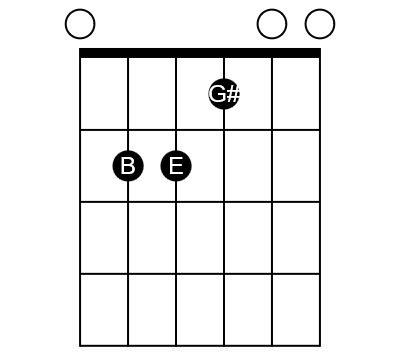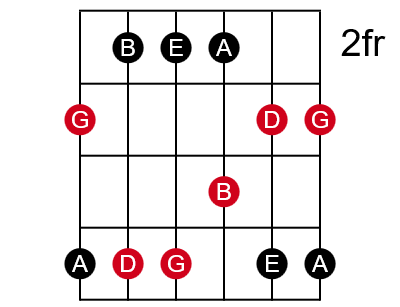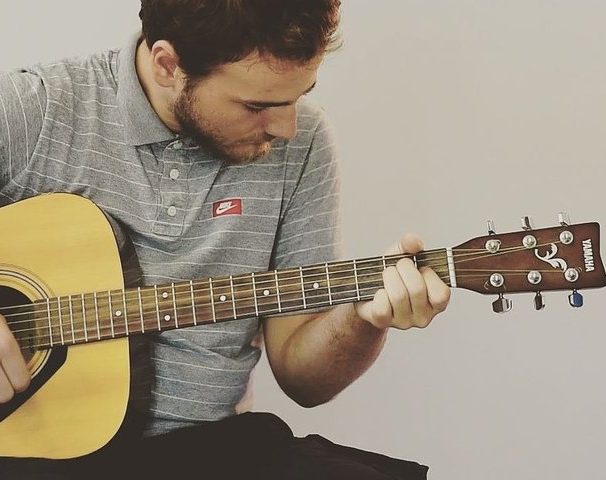
You might call the E chord on guitar the king of guitar shapes. It’s a full, rich, powerful chord. And yet it’s easy to play. And understanding the chord opens up many other tools for you as a player. Let’s take a look the the E chord on guitar and discover some of what it helps us understand and enables us to do.
What is an E chord on guitar?
Any chord that contains only the notes E, G#, and B is an E chord. The open E chord on guitar consists of both E strings and the B string open, the A string at fret 2 for a B note, the D string at fret 2 for another E note, and the G string at fret 1 for a G# note. Many other E chord shapes are available at different areas of the neck.

What’s special about the open E chord?
The open E chord, as I said earlier, might be considered the king of all guitar chords. Let’s see why I say that.
The E chord has a full, rich, powerful sound
On a guitar in standard tuning, the open E chord uses all six strings.
It also contains three different E notes, each in its own octave. In addition, it contains two B notes in different octaves.
Finally, the chord contains three open strings including the lowest note on the guitar, the open E note. All of this adds up to give the open E chord on guitar a full, rich, powerful sound.

It’s easy to make
To make the open E chord on guitar, you use one of the most comfortable and easy-to-play shapes of any chord.
Leave the two E strings and the B string open. Then press the G string at fret 1 with your pointer for the G#. Press the D string at fret 2 with your ring finger for another E note. Finally, press the A string at fret 2 with your middle finger for another B note.
Since this chord uses all six strings, you can strum any or all of them as you play.
You can easily bar and move the shape
When you shift your fingers to play the G string with your middle finger, the D string with your ring finger, and the A string with your pinky, you free your pointer for use as a bar. This makes the E chord shape moveable and enables you to make any other major chord.
Simply move your pointer to bar at the fret at which the note on the Low E string matches the chord you want to make. For instance, to play a G chord, move the bar to fret 3 and make the E chord shape. For an A, move the bar to fret 5. And so on for any other major chord.
Want to know more about bar chords?
What you can find inside the E chord on guitar
Aside from being easy to play and easily moveable, the E chord on guitar holds many other extremely useful elements. This includes perhaps the most popular power chord shape along with all three inversions of an E triad. The chord also exists within Box 1 of the E major pentatonic scale.
The E power chord
The first two notes of the E chord—the open E and the B note at fret 2 of the A string—are the root and the 5th scale degree of the E major scale. When you play just these two notes, you have an E power chord. You’ll most often see this written as E5 on chord charts.
Need to learn about power chords?
Thousands of songs use this form of the power chord. It sounds particularly powerful when you play it on an electric guitar with plenty of effects such as distortion, overdrive, and compression. But it is often also used with acoustic guitars.
Like the full E chord itself, you can move this power chord shape up and down the neck in order to play any power chord you need.
Root-position triad
The root position triad sits right within the core of the open E chord on guitar. The E at fret 2 of the D string gives you the root of the triad. Then G#, the 3rd of the triad chord, sits at fret 1 of the G string. Finally, the open B string gives you the 5th scale degree to finish out the triad.
Again, as with the full chord, you can move this triad anywhere up and down the neck to make any major triad you need. You just need to move your pointer up to the B string. Then use your middle finger on the G string and your ring finger on the D string.
With this shape, the root note sits under your ring finger. So, to play any major chord triad, move your ring finger to the note that serves as the root note of the triad.
For instance, to play an A triad, move your ring finger to fret 7 of the D string. Your middle finger then plays the C# at fret 6 of the G string. Finally, your pointer plays the E at fret 5 of the B string.
This triad shape proves to be extremely useful. It’s easy to play and move. And, since it includes the D string and the B string, it provides a good mix of richer lower tones and sparkly higher tones.
First inversion triad
The open E chord on guitar also contains the first inversion of the E major triad. This inversion exists on the three highest strings.
To play the first-inversion triad, play fret 1 on the G string for G#. Then play the open B and open High E strings.
To learn more about triads in general, read
You’re certain to recognize a theme here as you can also move this shape up and down the neck to create any other major triad you need. In this triad, the root note exists on the High E string.
To move this shape up and down the neck, bar the High E and B strings with your pointer. Play the G string with your middle finger. Create the small bar at the fret where the E-string note corresponds to the triad you want to play. For instance, to create a C triad, make your bar at fret 8.
You can make great use of this triad shape for lead guitar lines and accenting chord stabs. This inversion of the E triad provides sharp, sparkly sounds since it uses the three thinnest strings.
Second inversion triad
To complete our tour of the triads found withing the open E chord, let’s talk about the second inversion of the E major triad. While this inversion shape isn’t necessarily as common as the other two, it can still be quite useful.
This triad exists on the A, D, and G strings. Therefore it provides a rich, deep option for triads.
To play it, use the exact fingering of the open E chord, but strum just the A, D, and G strings.
Not to sound like a broken record, but like the others, you can move this triad shape up and down the neck to find a triad for every other major chord.
In this triad shape the root note sits on the D string. So, find the note on the D string that corresponds to the major triad you want to play. For instance, if you want a G triad, move your ring finger to the 5th fret.
Of course, move the other fingers along with it so you have the D note, the fifth, at fret 5 of the A string. You already found the root note G at fret 5 of the D string. And the 3rd, the B, sits under your pointer at fret 4 of the G string.
Box 1 of the major pentatonic scale
It’s very useful to understand that Box 1 of the E major pentatonic scale exists around the open E chord on guitar. Or, as another way to look at it, the open E chord exists within the E major pentatonic scale Box 1.

This figure shows the notes of the E major pentatonic scale. The red dots indicate the shape of the E major chord.
Notice that you can’t play the normal shape of Box 1 completely since a few of the notes in that box exist below the open string position.
Therefore, it’s a bit easier to see how the scale surrounds the chord shape if we move the shape up the neck. Let’s move the shape up to fret three where we have the G major bar chord using the E shape. In this figure you can see the full pentatonic scale and how the E shape (again shown with the red dots) sits within it.

Understanding this is very useful when it comes to switching back and forth between playing chords and lead guitar lines.
Notice that you can visualize the bar with your pointer at fret 3 to play the two G notes and the D note. Then the D, G, and B notes on the A, D, and G strings respectively.
This figure also makes it easy to visualize the three triad shapes we talked about earlier.
The D, G, and B notes on the A, D, and G strings form the second inversion of the major triad. On the D, G, and B strings, the G, B, and D notes form the root position of the G major triad. And finally, on the G, B, and E strings you can easily see the first inversion of the major triad with the B, D, and G notes.
If this discussion of the major pentatonic scale leaves you puzzled, read
Conclusion
One could make the argument that the open E chord on guitar might be the most important shape to understand. As we deconstruct the chord we find much valuable knowledge inside of it.
The chord shape uses all six strings and contains three open strings, three E notes (including the lowest note on the guitar), and two B notes. All of these attributes make the chord rich and powerful.
It’s also a very easy shape to play. In addition you can move it up and down the neck as a bar chord to create every other major chord.
Inside the chord we find all three inversions of the major triad. You can also move these three inversion shapes up and down the neck to make any other major triad.
Finally, the chord shape sits within Box 1 of the major pentatonic scale. This make it easy to switch between playing the chord itself and lead lines based on the major pentatonic scale.
This anatomy of the E major chord on guitar make it an exceptionally rich source of guitar knowledge.

easy chord
It is once you know it!
heheheheheh nice man i like it
Great! Thanks.